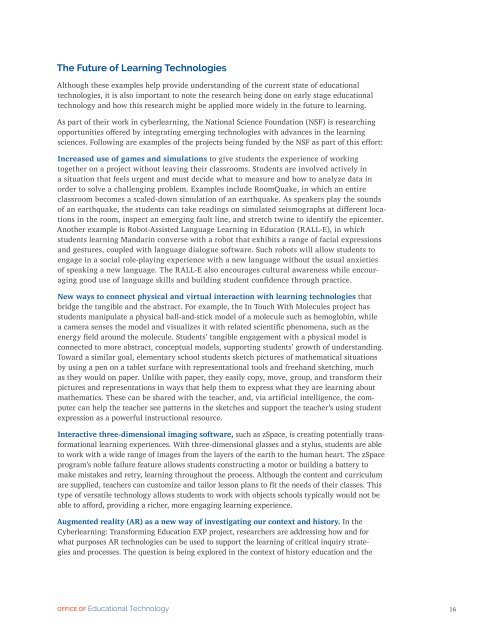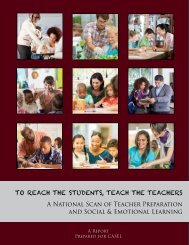Future Ready Learning
7m3sdJ
7m3sdJ
Create successful ePaper yourself
Turn your PDF publications into a flip-book with our unique Google optimized e-Paper software.
The <strong>Future</strong> of <strong>Learning</strong> Technologies<br />
Although these examples help provide understanding of the current state of educational<br />
technologies, it is also important to note the research being done on early stage educational<br />
technology and how this research might be applied more widely in the future to learning.<br />
As part of their work in cyberlearning, the National Science Foundation (NSF) is researching<br />
opportunities offered by integrating emerging technologies with advances in the learning<br />
sciences. Following are examples of the projects being funded by the NSF as part of this effort:<br />
Increased use of games and simulations to give students the experience of working<br />
together on a project without leaving their classrooms. Students are involved actively in<br />
a situation that feels urgent and must decide what to measure and how to analyze data in<br />
order to solve a challenging problem. Examples include RoomQuake, in which an entire<br />
classroom becomes a scaled-down simulation of an earthquake. As speakers play the sounds<br />
of an earthquake, the students can take readings on simulated seismographs at different locations<br />
in the room, inspect an emerging fault line, and stretch twine to identify the epicenter.<br />
Another example is Robot-Assisted Language <strong>Learning</strong> in Education (RALL-E), in which<br />
students learning Mandarin converse with a robot that exhibits a range of facial expressions<br />
and gestures, coupled with language dialogue software. Such robots will allow students to<br />
engage in a social role-playing experience with a new language without the usual anxieties<br />
of speaking a new language. The RALL-E also encourages cultural awareness while encouraging<br />
good use of language skills and building student confidence through practice.<br />
New ways to connect physical and virtual interaction with learning technologies that<br />
bridge the tangible and the abstract. For example, the In Touch With Molecules project has<br />
students manipulate a physical ball-and-stick model of a molecule such as hemoglobin, while<br />
a camera senses the model and visualizes it with related scientific phenomena, such as the<br />
energy field around the molecule. Students’ tangible engagement with a physical model is<br />
connected to more abstract, conceptual models, supporting students’ growth of understanding.<br />
Toward a similar goal, elementary school students sketch pictures of mathematical situations<br />
by using a pen on a tablet surface with representational tools and freehand sketching, much<br />
as they would on paper. Unlike with paper, they easily copy, move, group, and transform their<br />
pictures and representations in ways that help them to express what they are learning about<br />
mathematics. These can be shared with the teacher, and, via artificial intelligence, the computer<br />
can help the teacher see patterns in the sketches and support the teacher’s using student<br />
expression as a powerful instructional resource.<br />
Interactive three-dimensional imaging software, such as zSpace, is creating potentially transformational<br />
learning experiences. With three-dimensional glasses and a stylus, students are able<br />
to work with a wide range of images from the layers of the earth to the human heart. The zSpace<br />
program’s noble failure feature allows students constructing a motor or building a battery to<br />
make mistakes and retry, learning throughout the process. Although the content and curriculum<br />
are supplied, teachers can customize and tailor lesson plans to fit the needs of their classes. This<br />
type of versatile technology allows students to work with objects schools typically would not be<br />
able to afford, providing a richer, more engaging learning experience.<br />
Augmented reality (AR) as a new way of investigating our context and history. In the<br />
Cyberlearning: Transforming Education EXP project, researchers are addressing how and for<br />
what purposes AR technologies can be used to support the learning of critical inquiry strategies<br />
and processes. The question is being explored in the context of history education and the<br />
OFFICE OF Educational Technology<br />
16



